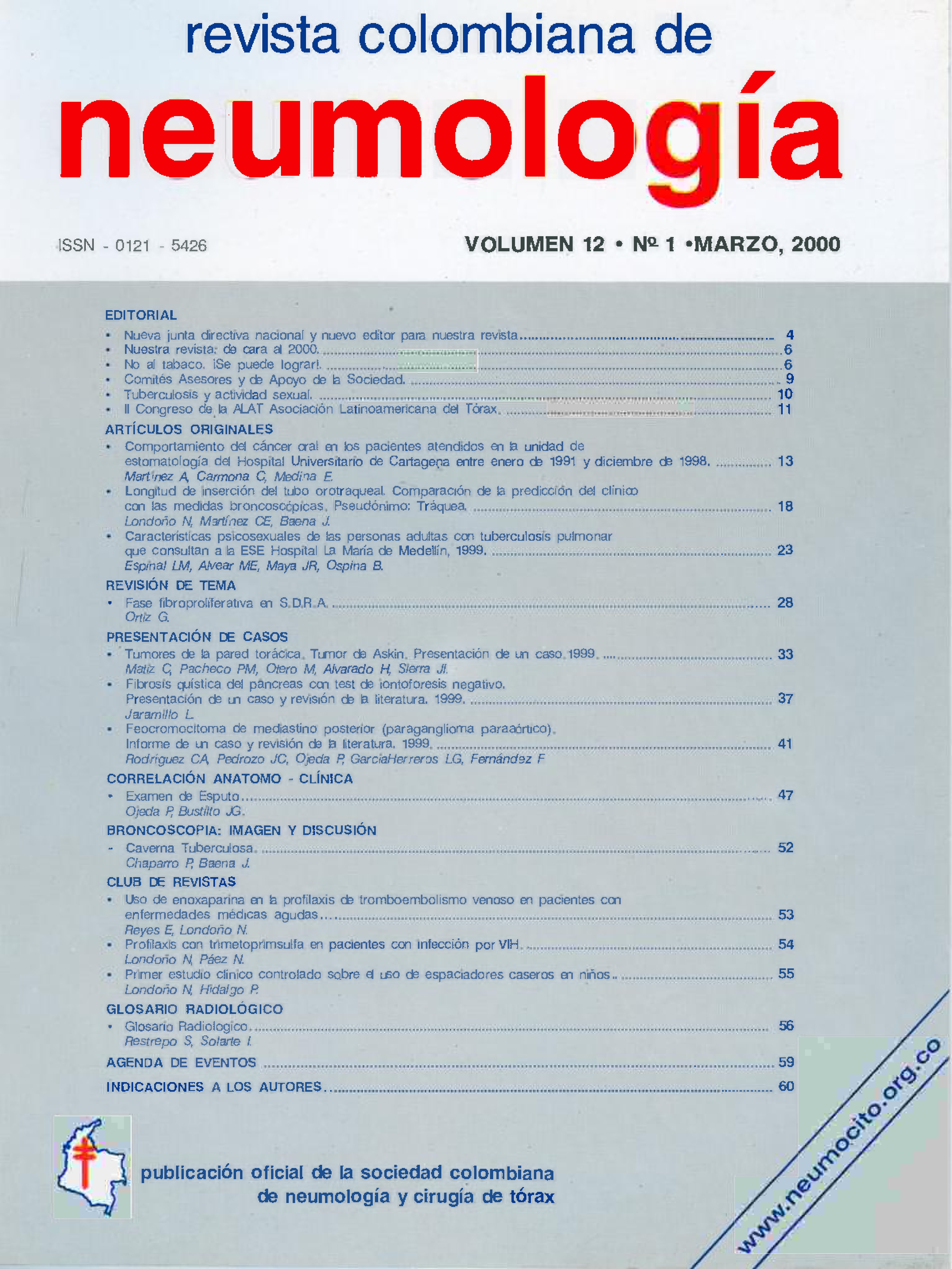Longitud de inserción del tubo orotraqueal. Comparación de la predicción del clínico con las medidas broncoscópicas. Pseudónimo: Tráquea
Longitud de inserción del tubo orotraqueal. Comparación de la predicción del clínico con las medidas broncoscópicas. Pseudónimo: Tráquea

This work is licensed under a Creative Commons Attribution-NonCommercial-ShareAlike 4.0 International License.
Ninguna publicación, nacional o extranjera, podrá reproducir ni traducir sus artículos ni sus resúmenes sin previa autorización escrita del editor; sin embargo los usuarios pueden descargar la información contenida en ella, pero deben darle atribución o reconocimiento de propiedad intelectual, deben usarlo tal como está, sin derivación alguna.
Show authors biography
Background: lnappropiate position of endotra-cheal tube are very common. First step in the intubation process, blind decission about lenght of insertion, never has been subject of investigation.
Objective: To compare clinical prediction of the lenght of insertion with objective measures taken during fiberoptic bronchoscopy.
Design: Cross-sectional study.
Setting: Bronchoscopy unit al Hospital Santa Clara, Santafé de Bogotá.
Patients and Methods: Adult patients requiring nonurgent bronchoscopy. Befare the endoscopic procedure experienced e/inician were asked about estimated height and weight of the patient and about appopiate /enght of insertion of endotracheal tube in the case of emergency intubation. At the endoscopy comisure to carina distance was registered and the appropiate length range for the position of the tube was calculated. Main com-parison was trecuence of agreement between clínica/ prediction and the calculated range based in endoscopic measures.
Results: In 39 out of 65 patients included length of insertion predicted by the e/inician was in the range based in endoscopic measures. Predicted length was considered lower than expected in 4 and excesive in 22. However, median difference in the two nonappropiateposition groups was only 1 cm.
Conclusions: lnitial length of insertion of endotracheal tubes selected by the e/inician is appropiate in more than 60% of the cases and the remaining errors are mínima/, probably with no clínica/ implication. First step in the intubation process appears as ve¡y precisse.
Article visits 27 | PDF visits 37
Downloads
- Stauffer JL. Monitoring the use of tracheal tubes. Capítulo 34 en Tobin MJ (editor) Principies and practice ofintensive care monitoring. McGraw-Hill, NewGraw-Hill, New York, 1998:667-82.
- Goodman LR. Pulmonary support and monitoring apparatus. Capítulo 3 en Goodman LR and Puttman CE (editores) Critica! Care lmaging. 3'd. Edition. WB Saunders, Philadelphia, 1992:35-59
- Brainsky A, Fletcher RH, Glick HA, Lanken PN, Williams SV, Kundel HL. Routine portable chest radiographs in the medical intensive care unit, effects and costs. Crit Care Med 1997;25:801-5
- Hall JB, White SR, Karrison T. Efficacy of daily routine chest radiographs in intubated, mechanically ventilated patients. Crit Care Med 1991 ;19:689-93
- Henschkle CJ, Pasternack GS, Schroeder S, Hart KK, Herman PG. Bedside chest radiograpy: diagnostic efficacy. Radiology 1983;149:23-6
- Marini JJ, Wheeler AP. Airway intubation. Capítulo 6 en Marini JJ, Wheeler AP (editores) Critica! Care Medicine, the essentials. Williams & Wilkins, Baltimore 1997:104-15
- Conrady PA, Goodman LR, Lainge R, Singer MM. Alteration of endotracheal tube position, flexion and extension ofthe neck. Crit Care Med 1976;4:7-12.







